Mostrar el registro sencillo del ítem
dc.contributor.author
Zampini, Iris Catiana

dc.contributor.author
Salas, Ana Lilia

dc.contributor.author
Maldonado, Luis M.
dc.contributor.author
Simirgiotis, Mario J.
dc.contributor.author
Isla, Maria Ines

dc.date.available
2023-01-10T11:56:03Z
dc.date.issued
2021-01
dc.identifier.citation
Zampini, Iris Catiana; Salas, Ana Lilia; Maldonado, Luis M.; Simirgiotis, Mario J.; Isla, Maria Ines; Propolis from the Monte region in Argentina: A potential phytotherapic and food functional ingredient; MDPI AG; Metabolites; 11; 2; 1-2021; 1-16
dc.identifier.issn
2218-1989
dc.identifier.uri
http://hdl.handle.net/11336/184068
dc.description.abstract
The aim of this review is to provide overall information on Argentine propolis and to shed light on its potential, especially the one from the Monte region so as to support future research in the field. Around 1999, the Argentine propolis began to be chemically and functionally characterized to give it greater added value. Because Argentina has a wide plant biodiversity, it is expected that its propolis will have various botanical origins, and consequently, a different chemical composition. To date, five types have been defined. Based on their functionality, several products have been developed for use in human and veterinary medicine and in animal and human food. Because the Argentine propolis with the greatest potential is that of the Monte eco-region, this review will describe the findings of the last 20 years on this propolis, its botanical source (Zuccagnia punctata Cav.), its chemical composition, and a description of markers of chemical quality (chalcones) and functionality. Propolis can regulate the activity of various pro-inflammatory enzymes and carbohydrate and lipid metabolism enzymes, as well as remove reactive oxygen and nitrogen species. Consequently, it can modulate metabolic syndrome and could be used as a functional ingredient in food. Furthermore, hydroalcoholic extracts can act against human and animal pathogenic bacteria and human yeast, and mycelial pathogenic fungi. The ability to stop the growth of post-harvest pathogenic bacteria and fungi was also demonstrated. For this reason, Argentine propolis are natural products capable of protecting crops and increasing the lifespan of harvested fruit and vegetables. Several reports indicate the potential of Argentine propolis to be used in innovative products to improve health, food preservation, and packaging. However, there is still much to learn about these natural products to make a wholesome use of them.
dc.format
application/pdf
dc.language.iso
eng
dc.publisher
MDPI AG
dc.rights
info:eu-repo/semantics/openAccess
dc.rights.uri
https://creativecommons.org/licenses/by/2.5/ar/
dc.subject
ANTIMICROBIAL AND NEMATICIDAL
dc.subject
ARGENTINE PROPOLIS
dc.subject
CHALCONES
dc.subject
CHALCONES
dc.subject
FREE RADICAL SCAVENGING ACTIVITY
dc.subject
METABOLIC SYNDROME
dc.subject
ZUCCAGNIA PUNCTATA
dc.subject.classification
Otras Ciencias Biológicas

dc.subject.classification
Ciencias Biológicas

dc.subject.classification
CIENCIAS NATURALES Y EXACTAS

dc.title
Propolis from the Monte region in Argentina: A potential phytotherapic and food functional ingredient
dc.type
info:eu-repo/semantics/article
dc.type
info:ar-repo/semantics/artículo
dc.type
info:eu-repo/semantics/publishedVersion
dc.date.updated
2022-09-23T10:12:24Z
dc.journal.volume
11
dc.journal.number
2
dc.journal.pagination
1-16
dc.journal.pais
Suiza

dc.description.fil
Fil: Zampini, Iris Catiana. Universidad Nacional de Tucumán. Instituto de Bioprospección y Fisiología Vegetal. Consejo Nacional de Investigaciones Científicas y Técnicas. Centro Científico Tecnológico Conicet Noa Sur. Instituto de Bioprospección y Fisiología Vegetal; Argentina
dc.description.fil
Fil: Salas, Ana Lilia. Universidad Nacional de Tucumán. Instituto de Bioprospección y Fisiología Vegetal. Consejo Nacional de Investigaciones Científicas y Técnicas. Centro Científico Tecnológico Conicet Noa Sur. Instituto de Bioprospección y Fisiología Vegetal; Argentina
dc.description.fil
Fil: Maldonado, Luis M.. Instituto Nacional de Tecnología Agropecuaria. Centro Regional Tucuman-Santiago del Estero. Estación Experimental Agropecuaria Famaillá; Argentina
dc.description.fil
Fil: Simirgiotis, Mario J.. Universidad Austral de Chile; Chile
dc.description.fil
Fil: Isla, Maria Ines. Universidad Nacional de Tucumán. Instituto de Bioprospección y Fisiología Vegetal. Consejo Nacional de Investigaciones Científicas y Técnicas. Centro Científico Tecnológico Conicet Noa Sur. Instituto de Bioprospección y Fisiología Vegetal; Argentina
dc.journal.title
Metabolites
dc.relation.alternativeid
info:eu-repo/semantics/altIdentifier/url/https://www.mdpi.com/2218-1989/11/2/76
dc.relation.alternativeid
info:eu-repo/semantics/altIdentifier/doi/http://dx.doi.org/10.3390/metabo11020076
Archivos asociados
